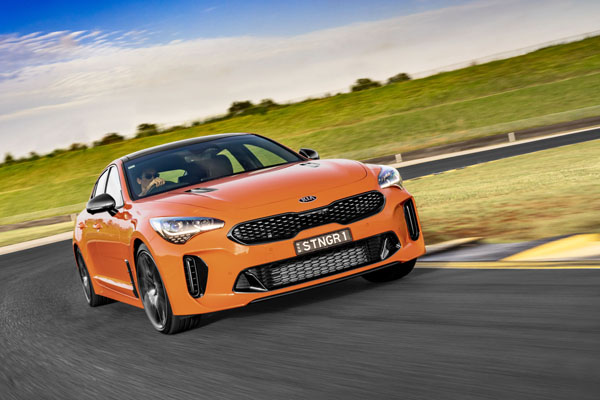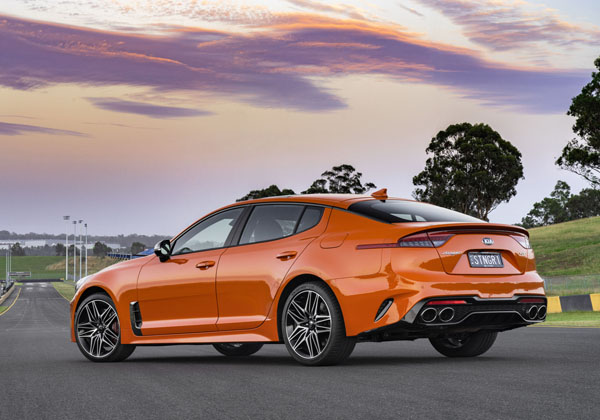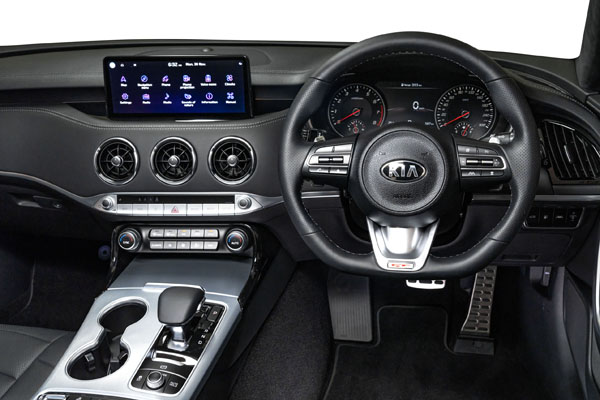
The Stinger GT has a new spring in its step and added sting in the tail, thanks to a new factory-developed exhaust system and LED combination tail lamp layout, plus upgraded safety tech.
The Kia MY21 sports sedan flag bearer heads a rejigged range, with a choice of a four-cylinder or V6 engine, driving the rear wheels through an eight-speed automatic transmission.
The twin-turbo V6 powered Kia has forging a strong link with police services around Australia as an operational intercept and road command vehicle.
Buyers can get to experience the Stinger’s gran turismo personality with the entry-level 200 S and its turbo-charged 2.0-litre four-cylinder motor for a drive-away price of $53,090, while the much heralded 3.3 litre twin-turbo V6 GT, at $67,690 drive away, garners little touches that add greatly to the appeal. Then there’s the Kia seven-year unlimited kilometre warranty.
STYLING
Kia says designers toned down any brutal characteristics, combining elegance with an athletic look. Not that everything is soft and gentle. There is still the Kia signature ‘tiger-nose’ grille, bold LED headlamps and two twin oval exhaust pipes with larger tips than previously, while the clever dynamic bending headlights are retained.

A flat underbody and rear diffuser enhance aerodynamics. A new alloy wheel design has thinner spokes than before to further highlight the high performance Brembo brakes.
Indeed, the Neon Orange Stinger GT test vehicle was a sight to behold, a fact that did not go un-noticed on the street.
INTERIOR
Upgrades are led by a dash-mounted 1.25-inch touchscreen, with in-built satellite navigation and smartphone connectivity, allowing monitoring and control of a range of vehicle systems at the same time.
Cabin ambience can be subtly controlled by a choice of 24 colours in a mood lamp. The steering wheel now features a metallic finish, while dashboard and doors are trimmed with a new stitch pattern. The seats of the GT were dressed in black Nappa leather.

INFOTAINMENT
Technology upgrades are led by Bluetooth multi-connection, which allows multiple smart phones to be paired simultaneously for greater convenience such as communicating on one phone while streaming music on another. A harman/kardon 15-speaker Premium sound system also does the honours here.
ENGINES / TRANSMISSIONS
Kia Stinger GT’s engine basically remains unchanged, the Lamda 3.3-litre twin-turbo V6 still winding up to 510 Nm of torque across a wide rev range, but the addition of a factory-developed bi-modal exhaust stumping up an extra 2 kW of power, boosting output to 274 kW.
The turbocharged 2.0-litre four-cylinder motor is carried over with its 182 kW of power and 353 Nm of torque. Both are mated with an eight-speed automatic transmission.
SAFETY
Improved autonomous emergency braking now has cyclist detection and junction assist, the latter using a camera and radar to apply the brakes if danger is detected while turning across oncoming traffic.
Road edge detection has been added to lane keeping assist, if the car is heading off the road and lane following assist uses a camera to keep the vehicle out of the weeds. Rear cross-traffic collision avoidance brakes to avoid traffic from either side when reversing.
DRIVING
With 510 Nm torque topping out at a low 1300 rpm and sticking around until 4500 revs the Stinger GT is not shy on showing its versatility – on the one hand a grand tourer, on the other an out-and-out sports sedan.
Then, there’s the 274 kW of power, peaking at 6000 rpm, with a nod to the racetrack with launch control. Left foot on the brake and gearshift in drive; flatten the accelerator pedal and release the foot brake, and whoosh. The drivetrain goes ga-ga with an accompanying turbo-boosted engine / exhaust noise.
There’s a firm shove on the back as the car takes off and I couldn’t argue with the claimed zero-to-100 kilometre time of less than 5 seconds. With official combined urban / highway fuel consumption of 10.2 litres per 100 kilometres, the test car came up with 13-plus around town and 6.2 on a motorway run.
There are five different dial-up driving modes – Sport, Comfort, Eco, Smart and Custom – the last had the car coming to terms with the highly variable road conditions found in Australia, while Sport produced a rough ride more suitable for the smoother racetrack surfaces. Eco held little attraction.
Worth a mention is the blind spot monitor, which projects a camera image from the mirrors in the driver’s display as soon as the turn indicator is activated. The blind spot collision avoidance assist produces a warning and automatically controls the car to help avoid a collision.
A steeply-sloped rear window presents a limited view for the driver and misses out on a rear wiper, which just about wipes out a clear view behind in wet weather.
The smart key offers the chance to remotely start the engine and have the climate reach the optimum settings before getting into the cabin. Also smart is the power tailgate that can be set to four pre-determined opening heights from an in-car menu.
SUMMARY
The Stinger GT gives full vent to the sports sedan fan’s every wish … at a somewhat steep price. The cheaper alternative is to become a highway patrol police officer!
AT A GLANCE
MODEL LINE-UP (all prices drive away)
Kia Stinger 200 S $53,090
Kia Stinger GT-Line $60,690
Kia Stinger 330 S $56,890
Kia Stinger GT $67,690
SPECIFICATIONS (Kia Stinger 3.3L GT Twin Turbo 6-cylinder petrol, 8sp automatic, rear-wheel drive sedan)
ENGINE:
Capacity: 3.342 litres
Configuration: Six cylinders in ‘V’
Maximum Power: 274 kW @ 6000 rpm
Maximum Torque: 510 Nm @ 1300-4500 rpm
Fuel Type: Petrol 91 RON
Combined Fuel Cycle (ADR 81/02): 10.2 L/100km
CO2 emissions 239 g / km
DRIVELINE: Eight-speed shift-by-wire automatic, limited-slip differential, rear-wheel drive
DIMENSIONS, WEIGHT AND CAPACITIES:
Length: 4830 mm
Wheelbase: 2905 mm
Width: 1870 mm
Height: 1400 mm
Turning Circle: 11.2 metres
Tare weight: 1383 kg
Fuel Tank Capacity: 60 litres
BRAKES:
Front: Ventilated disc
Rear: Ventilated disc
STANDARD WARRANTY:
Seven years / unlimited kilometres











